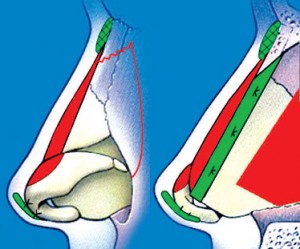Rhinoplasty in India
What is Rhinoplasty ?
Rhinoplasty is a plastic surgery procedure for correcting and reconstructing the form, restoring the functions, and aesthetically enhancing the nose, by resolving nasal trauma (blunt, penetrating, blast), congenital defect, respiratory impediment, or a failed primary rhinoplasty. In the surgeries — closed rhinoplasty and open rhinoplasty — an otolaryngologist (ear, nose, and throat specialist), a maxillofacial surgeon (jaw, face, and neck specialist), or a plastic surgeon creates a functional, aesthetic, and facially proportionate nose by separating the nasal skin and the soft tissues from the osseo-cartilaginous nasal framework, correcting them as required for form and function, suturing the incisions, and applying either a package or a stent, or both, to immobilize the corrected nose to ensure the proper healing of the surgical incision.
The structures of the nose
For plastic surgical correction, the structural anatomy of the nose comprehends:
A. the nasal soft tissues
B. the aesthetic subunits and segments
C. the blood supply arteries and veins
D.the nasal lymphatic system
E.the facial and nasal nerves
F.the nasal bones
G.the nasal cartilages.
Rhinoplasty

Nasal analysis
The surgical management of nasal defects and deformities divides the nose into Five (5) anatomic subunits:
(i) the dorsum
(ii) the sidewalls (paired)
(iii) the hemilobules (paired)
(iv) the soft triangles (paired)
(v) the alae (paired)
Surgical correction and reconstruction comprehend the entire anatomic subunit affected by the defect (wound) or deformity, thus, the entire subunit is corrected, especially when the resection (cutting) of the defect encompasses more than 50 per cent of the subunit.